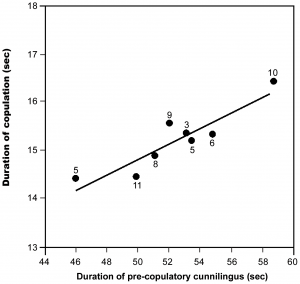Several years ago a student of mine (Christy McGee) in my “Anthropology of Sex” class was studying highly promiscuous women with the hypothesis that they would be averse to cunnilingus. She suggested that cunnilingus was a male means of detecting infidelity. I will admit my skepticism at the time, not because it seemed far-fetched but because it seemed so difficult to test. Instead, I pushed her toward considering a bonobo model to test whether there was any adaptive basis (read “phylogenetic” basis) for cunnilingus to begin with.
In querying the only person I knew who might have thought about this, Gordon Gallup, who was one of my grad advisers, had actually blogged on this very topic & posited that cunnilingus was a human cultural practice. He posited that bonobo (& chimp) vaginas would collect sweat & be the site of chemical warfare (between pathogens trying to get in & vaginal acids staving them off) that produced unsavory byproducts, such that, even if cunnilingus was experimented with by young apes, they would develop a learned taste aversion.
After visiting the Memphis Zoo & observing their bonobos, I concluded from the shape & position of bonobos labia that this scenario is highly unlikely. The orientation makes it physically implausible. I seem to recall discussing this in an early blog with photos, so I direct you there.
The only other experts I’ve ever mentioned this to looked at me like I was nuts (Frans de Waal—yeah, right? Frans de Waal of all people—even though he has the only data I could find on the topic, which he didn’t seem to recall publishing) & ignored me (someone at AAPA whose name escapes me). Nonetheless, after years of speculating about this in class & lab, one of my excellent & ambitious HBERG students, Erica Schumann, took on the project I’ve been proposing for years. She took videocameras to the Fort Worth & Memphis Zoos to record bonobo behavior & code specifically for cunnilingus!
On a sad side note: The lone male at the Memphis Zoo was unexpectedly separated from the several females when Erica went to collect data & subsequently died before she could return.
Okay, how do I follow that with what I’m excited about today? Well, more on her exciting (& arousing!) research later. But relevant to it, I saw this tweet earlier tonight:
https://twitter.com/juliawatzek/status/522549070079225856
And replied with a comment only a primatologist interested in sexual behavior could appreciate:
@juliawatzek @amanda_dettmer holy shit! we've been trying to study cunnilingus in bonobos (seriously) & never thought of BATS!
— Christopher Lynn (@Chris_Ly) October 16, 2014
Male bats are using cunnilingus to render females receptive to copulation, either stimulating vaginal secretions or, you know, other stuff (what other stuff?).

Figure 1. Relationship between duration of pre-copulatory cunnilingus and copulation.
Circles and numbers indicate average duration of copulation and n value, respectively.
doi:10.1371/journal.pone.0059743.g001
Watch them go! This is fascinating. And, honestly, is it possible that we’re unaware of the breadth of mammalian fellatio & cunnilingus because it’s practically impossible to see what’s going on when small furry animals in trees are doing the nasty? I mean, most don’t hang upside down like two shirts (with penises & vaginas) tangling up on a clothesline for us to watch.
(I can’t get the damn video to embed, so here is the link to it)
And this has me thinking, is human cunnilingus an adaptation to make females more sexually receptive? This seems like a stupid question, but, I guess what I’m asking, is it more than a cultural adaptation? Is it a case of convergent evolution, wherein two species have converged on the same adaptation to increase female receptivity where sperm competition is relatively high? And how can we test this?

A trip to the zoo should clue you in that oral sex is widely practiced, particularly cunnilingus. In fact, females of some species have very large clitorises so several males can lick at the same time. Oral sex is not simply foreplay but a form of bonding where intercourse may or may not occur. Remember, most primates and monkeys have estrus periods, but they still have sex constantly. So, intercourse is not necessarily, and hardly understood causally, as related to pregnancy.
What I am waiting to see are ads that promote oral sex instead of drugs like Cialis or Viagra to get males erect and aroused!
Yep, it’s a stupid question. A minimal requirement for considering something an adaptation is evidence of a genetic basis. Instead, we have something that is highly culturally variable. Step 0 would be a comparison of human cultures to see if there is any evidence that it’s even widespread, and if it’s historically recent or not. Aren’t you an anthropologist, for godssakes? And why don’t evpsych types ever seem to read Gould’s spandrels paper? Bah!
Ps the bat paper is a few years old, it’s not news any more.